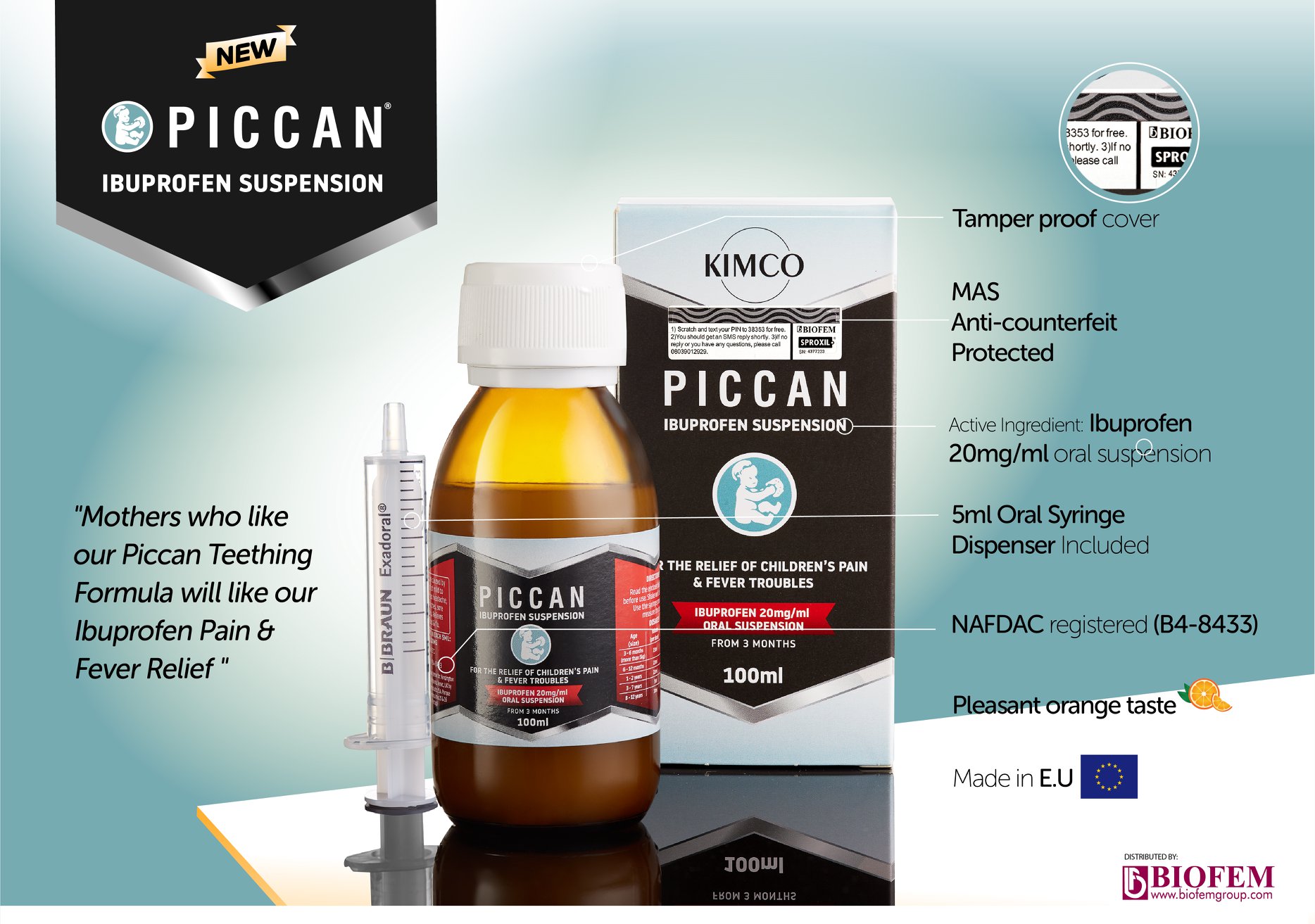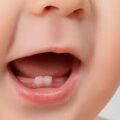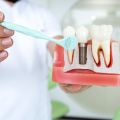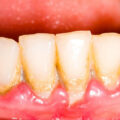
Piccan syrup is a teething remedy used for the relief of fever and pains as a result of teething in infants. Teething can be a time of great frustration for parents and caregivers, Piccan help soothe your little one during this potentially uncomfortable time. Teething usually starts around four to eight months with the lower front teeth and continues until 30-36 months of age when the last set of molars appear.
During the teething period there are symptoms that include irritability, disrupted sleep, swelling or inflammation of the gums, drooling, loss of appetite, rash around the mouth, mild temperature, diarrhea, increased biting and gum-rubbing and even ear-rubbing. These symptoms were reported by 70-80 percent of parents according to an article from the British Dental Journal.
Ingredients in Piccan
Each 5ml of Piccan Syrup contains Paracetamol Ph.Eur 120mg and Diphenhydramine HCL Ph.Eur 12.5mg.
Direction for Use
It is important to know when to give your baby piccan. For children between 3 months and one year, administer half to one teaspoonful (2.5ml) 3 to 4 times daily. For children between the age of one to five years give 1 to 2 teaspoonfuls (5 to 10ml) 3 to 4 times daily. For children 6 years and above give 2 to 4 teaspoonfuls (10 to 20ml) 3 times daily. Allow at least four hours between doses or use as directed by your doctor.
Side-effects Of Piccan
The following is a list of possible side-effects that may occur from all constituting ingredients of Piccan Teething Remedy Liquid. This is not a comprehensive list. These side-effects are possible, but do not always occur. Some of the side-effects may be rare but serious. Consult your doctor if you observe any of the following side-effects, especially if they do not go away.
- Swollen facial features
- Feeling of sickness
- Skin reddening
- Allergic reactions
- Shortness of breath
- Liver damage
- Abnormalities of blood cells
- Nausea
- Rashes
- Liver toxicity
- Less white blood cells
- Acute renal tubular necrosis
- Blood dyscrasias
- Flushing
- Tachycardia
- Blurred vision
- Delirium
- Toxic psychosis
- Urinary retention
- Respiratory depression
- Urticaria
- Drug rash
- Photosensitivity
- Hemolytic anemia
- Hypotension
- Epigastric distress
- Anaphylactic shock
- Tightness of the chest
- Wheezing
Piccan Teething Remedy Liquid may also cause side-effects not listed here.
If you notice other side-effects not listed above, contact your doctor for medical advice. You may also report side-effects to your local food and drug administration authority.
How To Spot A fake Piccan
The Nigerian Pharmaceutical market is replete with counterfeited products smuggled into the country without going through regulatory processes. In Nigeria, Piccan is distributed by Biofem Pharmaceutical group and the new Piccan comes with an anti-counterfeiting scratch card to confirm the authenticity of each bottle of the product.
Precautions
Before using Piccan Teething Remedy Liquid, inform your doctor about your current list of medications, over the counter products (e.g. vitamins, herbal supplements, etc.), allergies, pre-existing diseases, and current health conditions (e.g. pregnancy, upcoming surgery, etc.). Some health conditions may make you more susceptible to the side-effects of the drug. Take as directed by your doctor or follow the direction printed on the product insert. Dosage is based on your condition. Tell your doctor if your condition persists or worsens. Important counseling points are listed below.
- Avoid using it if allergic to paracetamol
- Do not take paracetamol if you consume alcoholic beverages every day
- Do not breathe vapors, mist or gas
- Do not swallow
- Infants
- Patients with asthma
- Young children
Caution
Do not exceed the stated dose. Prolonged use without medical supervision can be dangerous. Routine use is not recommended. If symptoms persist consult your doctor immediately. Do not give to children under 3 months except under doctor’s advice. May cause drowsiness. Children taking the medication should be kept under close supervision. Store in a dry cool place away from the reach of children.
What’s the best way to soothe sore gums?
If your teething baby seems uncomfortable, consider these simple tips:
Rub your baby’s gums: Use a clean finger or wet gauze to rub your baby’s gums. The pressure can ease your baby’s discomfort.
Keep it cool: A cold spoon or chilled — not frozen — teething ring can be soothing on a baby’s gums. To avoid cavities, don’t dip these items in sugary substances.
Try an over-the-counter remedy. If your baby is especially cranky, consider giving him or her infants’ or children’s over-the-counter pain medications such as Piccan, babyrex or bonababe.
What treatments should I avoid?
To keep your baby safe, avoid using: Over-the-counter remedies, including homeopathic teething tablets. The benefits of topical gels and teething tablets haven’t been demonstrated. In recent years, lab analysis of some homeopathic remedies found greater amounts than labeled of the ingredient belladonna, which can cause seizures and difficulty breathing.
Teething medications containing benzocaine or lidocaine. These pain relievers can be harmful even fatal to your baby.
Teething necklaces, bracelets or anklets. These items pose a risk of choking, strangulation, mouth injury and infection.
Do I need to call the doctor?
Teething can usually be handled at home. Contact the doctor if your baby seems particularly uncomfortable or if teething seems to be interfering with his or her eating or drinking.
How do I care for my baby’s new teeth?
Run a soft, clean cloth over your baby’s gums twice a day after the morning feeding and before bed. The cleansing can keep food debris and bacteria from building up in your baby’s mouth.
When your baby’s first teeth appear, use a small, soft-bristled toothbrush to clean his or her teeth twice a day. Until your child learns to spit at about age 3 — use a smear of fluoride toothpaste no bigger than the size of a grain of rice. Then switch to a pea-sized dollop as your child approaches 2 to 3 years of age.
It’s also time to think about regular dental checkups. The American Dental Association and the American Academy of Pediatric Dentistry recommend scheduling a child’s first dental visit at or near his or her first birthday.





